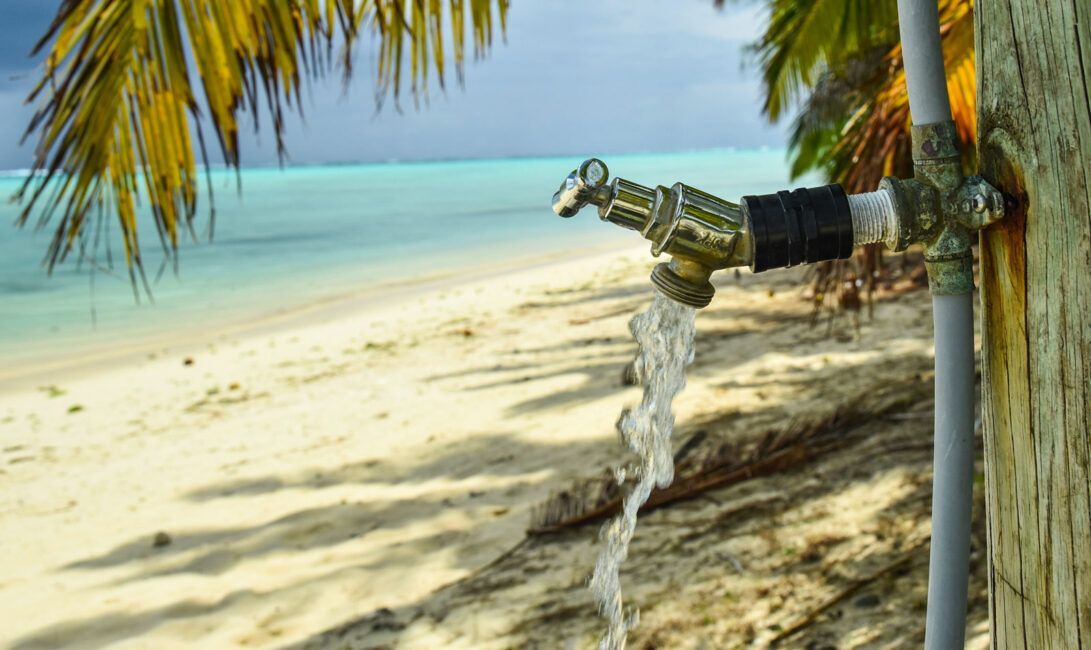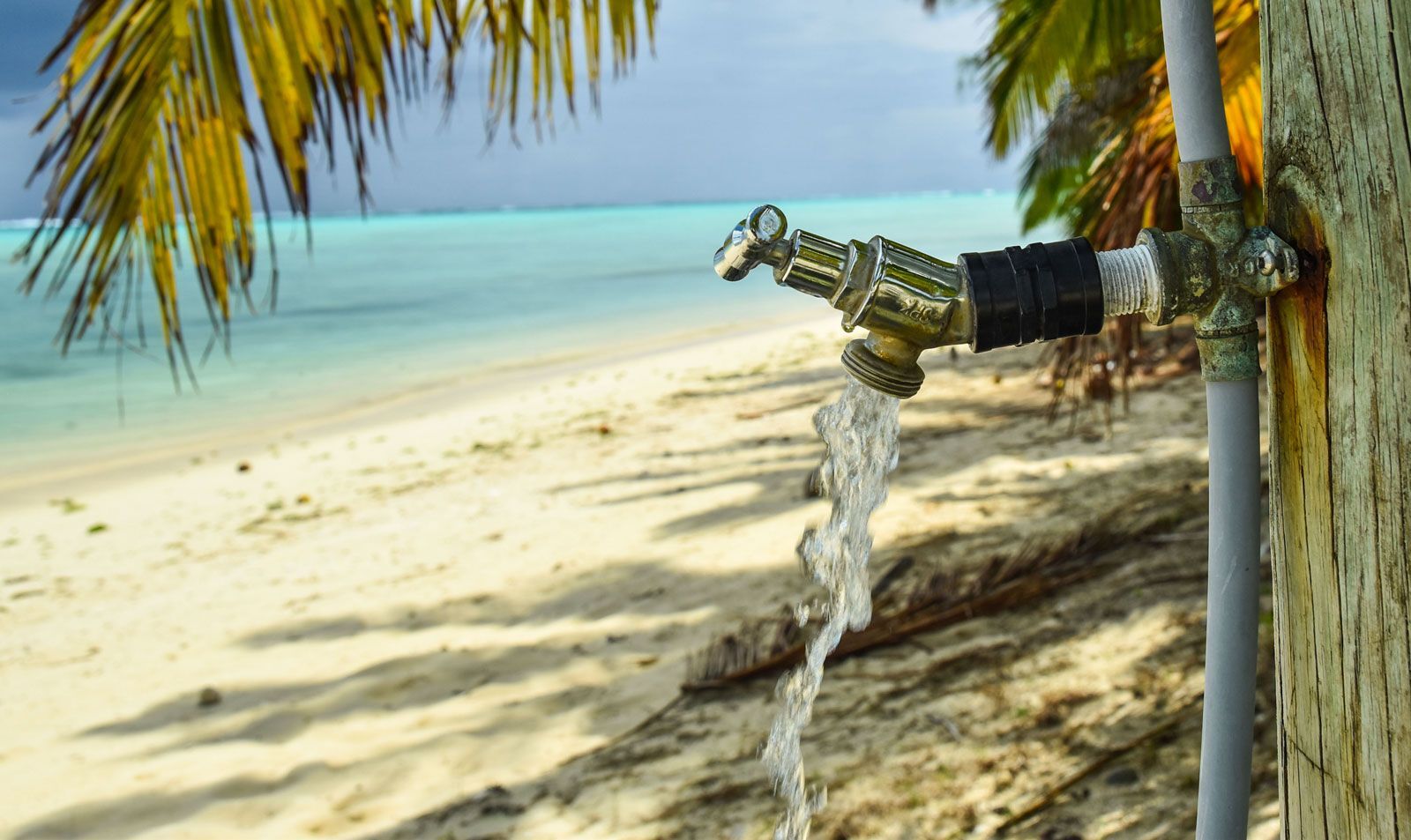Is the Water Safe to Drink in Rarotonga and the Cook Islands?
The Cook Islands gets its water from surface water sourced from springs and streams within catchment valleys, particularly in the Southern Group and Rarotonga, while rainwater and groundwater collection is the main drinking water source in the Northern Group. The Cook Islands does not have chemical water treatment, relying mainly on coarse gravel filters to remove solids and organic matter from its water supply. So, can you drink the water in Rarotonga and the Cook Islands?
In some large accommodations on Rarotonga, filtration is a big deal and you will be safe to drink tap water and to add refreshing ice to your drinks (most restaurants use commercially made ice anyway). Outside of the resorts with filtration systems, a bit more attention should be paid. It is possible to catch traveller’s diarrhoea (a common waterborne form of E.coli) from drinking untreated water. But there’s no need to panic, if you follow the simple tips in this article, you’ll be able to have a safe trip to the Cook Islands while staying hydrated!
For more information about staying healthy when travelling to the Cook Islands, check out our Cook Islands Safety Tips and What to Medication to Pack for the Cook Islands.
6 Ways to Make Sure the Water is Safe to Drink in the Cook Islands
If you have any doubt about drinking the water in Rarotonga and the Cook Islands, follow these tips on making sure the water is safe to drink…
- Boil the water first – boiling water for 10 minutes or longer kills bacteria and is the best way to make sure water is safe to drink
- Use a Lifestraw Bottle – it includes a filtration system that makes your water safe to drink while also avoiding the use of disposable water bottles
- Stay at a resort/accommodation with a water filtration system – Some of the main accommodations and resorts in the Cook Islands provide filtrated tap water for their guests, so ask if the water is safe to drink when researching a place to stay. Once at your accommodation, you can refill your bottles there before heading out
- Scout out water stations – There are several water stations across Rarotonga (Te Ara Museum, for example) and Aitutaki (there are UV-filtered water stations in many villages) where you can refill water bottles with treated water
- Use water purifying tablets – This method comes as little sachets or tablets and, when mixed into your water for a certain amount of time, will kill most bacteria and parasites present in it making it safe to drink
- Drink bottled water – Although not environmentally -friendly, buying bottled water from your resort or a supermarket is a good way to stay safe.
We elaborate further on these points in the “The Best Ways to Make Sure Water is Safe to Drink” section below.
Is it Easy to Access Drinking Water in Rarotonga and the Cook Islands?
It is not hard for travellers to access safe drinking water in the Cook Islands, especially on Rarotonga and Aitutaki. Many of the resorts and upmarket accommodations on Rarotonga and some in Aitutaki have effective filtration systems so that their guests can drink the tap water with peace of mind. Alternatively, resorts will provide filtered glass bottles of water in your room, which will be refilled with room service and/or they will inform you on where you can refill the bottles yourself (usually at the bar or reception).
For those not staying in such resorts, self-catering accommodations such as holiday homes and motels with kitchenettes provide the facilities to boil the tap water before drinking. Note that boiling water in a kettle (the jug) won’t effectively kill bacteria; water must be boiled for several minutes.
When out exploring the local villages, island hikes and many hidden gems that the Cook Islands has to offer, we suggest only drinking the water that you packed for yourself to avoid untreated water. In any case, you are rarely more than a 30-45 minutes drive from your accommodation, store or filtered water station so there is never really cause for panic.
Water Stations
You’ll notice water stations while driving around Rarotonga and Aitutaki. They are well signposted, found along the roadsides and typically consist of a couple of taps under a shelter. Only drink the water from these if the signs state that the water is treated (which typically is the case with UV filtration, but not always). There is also a water refill station inside the Te Ara Museum, Rarotonga.
Bottled Water in the Cook Islands
If you are into bottled water, rest assured. Bottled water is easily accessible on Rarotonga and Aitutaki at local supermarkets. Make sure to dispose of your plastic waste responsibly after use (and reuse if possible).
Is the Water Treated in the Cook Islands?
The treatment facility for water on Rarotonga is rather basic compared to more developed countries. While the locals may find the water safe to drink, there may be higher concentrations or unfamiliar strains of bacteria, like E.coli, present in the water. It’s unlikely that visitors will have built up an immunity to particular bacterial strains, which can cause traveller’s diarrhoea. For this reason, it’s always sensible to assume that tap water is untreated and should be treated by yourself before drinking.
Although some public buildings, restaurants and accommodations have their own filtration system, whether it’s UV, chemical or carbon filters, treated water should not be expected everywhere. It is up to each building to provide its own treatment method.
Travellers should be extra cautious about drinking water in the outer islands of the Cook Islands, always treating the water themselves before drinking.
How is the Water Treated in Rarotonga and the Cook Islands?
Since every house, business and accommodation provider can choose if they want to treat their water and if so, how they want it to be treated, we recommend always asking if the water is treated before taking a big gulp from the tap. Most accommodation providers and restaurants will have treated tap water using one of the following methods:
- UV filters
- Carbon filter
- Chemical treatments
The Best Ways to Make Sure Water is Safe to Drink
Although it is highly unlikely you will run out of water when exploring the Cook Islands, knowing that you are always a short drive back to your accommodation or the main town, we have prepared a few ways to purify water so you can put that in your knowledge bank for any tropical adventure!
Boil the Water
Bringing the water to a boil for 10 minutes is probably the best-known method of purifying water. It kills parasites, bacteria and even viruses and ensures that it is fully safe to drink. Plus, it is the cheapest water purifying method out there.
Use Water Purification Tablets
Use your own water bottle, drop a water purifying tablet and “voila!” This method has been trialled and tested for years and despite the fact that it gives a bit of a weird taste to the water, it is widely used by travellers around the globe. If the taste is an issue for you, try a water-purifying solution. Although a bit more expensive, it offers better taste and water clarity than tablets. Price-wise, this is still going to save you tens of dollars compared to buying bottled water all trip long.
Buy a Water-Purifying Water Bottle
By far our favourite solution of them all, water-purifying bottles like the Lifestraw Bottle remove 99.9999% of waterborne bacteria and 99.9% of waterborne protozoan. That means that there is no boiling necessary and that you can fill up your water bottle from most taps in the Cook Islands and know that you have a filtration system with you. Although they are not the cheapest option, once the initial purchase is done, all you have to do is to replace the filtration cartridge when it expires.
Although there are alternative brands to Lifestraw, this is just the one that the CookIslandsPocketGuide.com team use when travelling the Pacific, so we know we can recommend it. When looking for alternatives, make sure to search for “water-purifying” and not “water-filtration” as filtration only improves the taste of the water.
For more handy things to pack for the Cook Islands, check out What to Pack for Rarotonga & the Cook Islands: Cook Islands Packing List.
More About Health and Safety for Visiting the Cook Islands
That’s it for our guide to drinking tap water in Rarotonga and the Cook Islands but by no means the end of our Cook Islands advice. Check out more health and safety tips in the following articles:
- The Best Sunscreens for the Cook Islands + Sun Protection Tips
- 10 Ways to Avoid Mosquito Bites in the Cook Islands
- Is it Safe to Travel to Rarotonga & the Cook Islands? – Cook Islands Safety Tips
Finally, get more essential advice from The Best Cook Islands Travel Guide or the 30 Tips for Travelling in Rarotonga & the Cook Islands.
Author
Robin C.
This article was reviewed and published by Robin, the co-founder of Cook Islands Pocket Guide. He has lived, worked and travelled across 16 different countries before settling in the South Pacific, so he knows a thing or two about planning the perfect trip in this corner of the world. Robin works and consults regularly with Cook Islands Tourism Corporation, a local government body representing the tourism industry. Robin is also the co-founder of several other South Pacific travel guides and is a regular host of webinars with the South Pacific Tourism Organisation.

